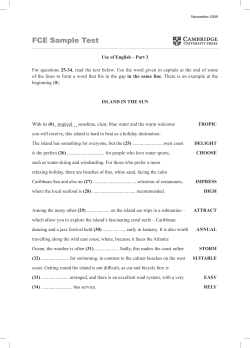
NETWORKING® 2020: - Networking Magazine
ADVISORY COMMITTEE HON. STEVE BELLONE Suffolk County Executive HON. EDWARD MANGANO Nassau County Executive HON. STEVE ISRAEL U.S. Congress HON. KENNETH LAVALLE NYS Senator JOHN D. CAMERON, JR., P.E. Managing Partner Cameron Engineering & Assoc., LLP ROBERT CATELL Chairman Advanced Energy Research and Technology Center BILL CHALEFF Chaleff and Rogers Architects NANCY RAUCH DOUZINAS NETWORKING ® MAGAZINE 2020: GUIDE TO GOING GREEN President, Rauch Foundation PETER ELKOWITZ President, CEO LI Housing Partnership “ There is no doubt that a few committed people can AMY ENGEL change the world. In fact, it is the only thing that ever has.” Executive Director Sustainable Long Island ROZ GOLDMACHER President, CEO Long Island Development Corporation — Margaret Mead AMY HAGEDORN Board Member, co-founder Sustainable Long Island SARAH LANSDALE Director, Division of Planning, Environment; Dept. of Economic Development & Planning, Suffolk County NEAL LEWIS, ESQ. Executive Director The Sustainability Institute at Molloy College DAVID MANNING Director, Stakeholder and Community Relations Officer, Brookhaven National Laboratory DR. ROBERT A. SCOTT President Adelphi University KEVIN MCDONALD Conservation Finance and Policy Director The Nature Conservancy, LI chapter MITCHELL H. PALLY Chief Executive Officer Long Island Builders Institute GORDIAN RAACKE Executive Director, RELI ® 18 NETWORKING June 2015 ROBERT A. SCOTT President, Adelphi University PAUL TONNA Executive Director Energeia Partnership, Molloy College MICHAEL E. WHITE Member of LI Commission for Aquafer Protection and member of Board of Governors for NYS SeaGrant “Not long ago, those who expressed concern about the human treatment of the land, air and water were considered idealists and dreamers, even antigrowth. Now, the U. S. military considers the status of potable water and the effects of climate change as matters of national security. Why, then, do so many of us still use excessive quanities of water, pollute the soil, discharge poisons into the air, and act as if earth is a renewable resource? Sure, we often find technological solutions to the problems we cause by inadequate design and execution, but this path often results in too little, too late. Our children's future depends upon our leadership to create a change in approach.” Sustainable Long Island’s Ninth Annual Conference PHOTOS BY CHRISTINE CONNIFF SHEAHAN AND SUSTAINABLE LONG ISLAND S Amy Engel, Executive Director, Sustainable Long Island, Bernadette Castro Keynote Speaker, Shari Gilfillan, Equity Strategist for Sustainable Investors, UBS Global Asset Management ustainable Long Island held its Ninth Annual Conference, Friday, April 17, 2015 at the Carlyle on the Green at Bethpage State Park – focusing on the theme of “Sustainable Solutions.” The keynote address was given by Bernadette Castro, former Commissioner of the New York Office of Parks, Recreation and Historic Preservation from 1995 – 2006 and CEO of the legendary furniture business Castro Convertibles. The conference featured workshops and the 5th Annual “Getting It Done” Awards. Recipients of “Getting it Done” Awards are: • The Town of North Hempstead’s School Recycling Partnership Program — Through this program the Town and the Solid Waste Management Authority provide recycling bins for every classroom, office, and high school sports field in each participating district, while facilitating the carting and recycling of paper, bottles and cans, bottle caps, and e-waste. • The Cedarmore Corporation — The Cedarmore Corporation is a 501(c)3 organization based in Freeport, New York and has evolved to serve the needs of youth and their families across Long Island. They are being awarded for their “Seed to Table” Community Garden project. • D’Addario & Company — D’Addario, a manufacturer of musical instrument strings, is committed to being environmentally responsible and inspires this sentiment in musicians worldwide. They promote the three E’s of sustainability: Economic Development, Social Equity and Environmental Health. Workshops topics were: Sustainability Business Basics, Smart Food Choices for the Future and The Region’s Resilient Resource. The “Sustainable Samplings” Luncheon offered food from American Classic Ice Cream, American Culinary Federation, Ayhan’s Shish Kebab, Bedell Cellars, Chartwells, The Curry Club, Divine Olive, Gino’s of Port Washington, La Bottega of Farmingdale, The Simon Center Café, Spring Brook Farms, Taste 99 Restaurant, Uncle Bacala’s and Verona Ristorante. ■ Amy Hagedorn, Founder, Sustainable Long Island, Ken Pritchard, Dr. Miriam K. Deitsch, Farmingdale State College, Board of Director, Sustainable Long Island Len Axinn, President, Island Estates Homes, and BOD, Sustainable Long Island Igor, Sikiric, Director of Solid Waste Management Authority, Town of North Hempstead, Amy Engel, Erin Reilley, Chief Sustainability Officer, and Bill Karavasilis, Sustainability Officer, Town of North Hempstead Kevin McDonald, Public Lands Program Director, The Nature Conservancy and BOD, Sustainable Long Island with Carl LoBue Luci Duckson-Bramble, Girl Scouts, and Ellen Palmisano, Evaluations and Grants Manager, Girl Scouts of Nassau County Wilma Holmes Tootle, President of The Links, Incorporated, Long Island Chapter and President, Big Apple Links Cluster Amy D’Addario, Director of Brand and Tom Stack, Architect Planning & Design, D’Addario & Company, Inc. Christopher Kent, Partner, Farrell Fritz, P.C., Charlotte Biblow, Partner, Farrell Fritz, and Board President, Sustainable Long Island, Dr. Wayne Horsley (Moderator), Regional Director, Long Island State Parks NETWORKING® June 2015 19 Debra Wheat-Williams, Director, Freeport Farmers’ Market Community Garden with Roberta Coward, Chairwoman, Cedarmore Corporation Panelists: Dr. Wayne Horsley (Moderator), Regional Director, Long Island State Parks; Carl LoBue, Senior Marine Scientist, The Nature Conservancy; Amanda Ludlow, Principal Scientist, Roux Sssociates, Inc.; Walter Meyer, ASLA, LeedAP, Adjunct Professor, Parsons New School; Rusty Schmidt, Landscape Ecologist, Nelson, Pope & Voorhis, LLC The Hempstead Plains Education and Research Center Cited for Sustainable Landscapes Friends of Hempstead Plains at Nassau Community College announces that its new Education and Research Center, received a two star SITES® Certification for Sustainable Landscapes 20 NETWORKING® June 2015 T he Education and Research Center, formerly referred to as Hempstead Plains Interpretive Center (HPIC), located on a 19 acre Hempstead Plains preserve at Nassau Community College, joins a select group of projects certified under the national Sustainable Sites Initiative® (SITES®) program for sustainable land planning, design, construction and maintenance. HPIC was awarded a two-star rating by the SITES program led by the Lady Bird Johnson Wildflower Center at The University of Texas at Austin, the United States Botanic Garden, and the American Society of Landscape Architects. The program has established best practices and performance-based benchmarks for developing and rating landscapes that have sustainable elements. The Center is one of the final 12 projects in 20 states to be certified using the pilot 2009 SITES guidelines. As such, the project helped test the rigorous, scientifically based content that led to the SITES v2 Rating System and Reference Guide. Achieving certification with the SITES 2009 Rating System meant HPIC had to fulfill 15 prerequisites, such as having an integrated approach to how landscape architects, engineers and others develop a site. The The new Hempstead Plains Education and Research Center at project was then awarded two Nassau Community College stars based on 51 potential credits, with points awarded for performance in credited areas such as the initial site selection, water, soil, vegetation, materials, human health and well-being, construction and maintenance. The Hempstead Plains is one of the last remaining remnants of a prairie east of the Allegheny Mountains. The design and development of the HPIC – a lowimpact building and site – in a heavily developed suburban area, secures the integrity of the parcel as a natural preserve and historic landmark. In addition, the location on the Nassau Community College campus and near several universities provides an opportunity for classes with a learning lab about native prairie habitats and sustainable techniques and gives general visitors the chance to experience prairie life. An entrance through native plantings leads to the new visitor’s center topped with a green roof; open and closed classrooms are provided. Handicapped-accessible and stabilized-soil trails lead to the natural Betsy Gulotta, Friends of Hempstead Plains Conservation paths in the native prairie. A cistern helps reduce the need for potable water. Solar Project Manager with Constance “Cece” Haydock, landscape energy provides power and the building is completely “off the grid.” architect and SITES Project Manager “We are pleased to be among those taking a lead in applying the SITES rating Friends of Hempstead Plains is a nonprofit environmental organization system to enhance the environmental, social and economic aspects of our project,” dedicated to preservation and restoration of the historic Hempstead Plains and to said Betsy Gulotta, Conservation Project Manager for Friends of Hempstead promotion of good stewardship of the land through education and research. Plains. “This certification is evidence of our commitment to the environment and The SITES program staff has been working for seven years in conjunction with a to our communities.” diverse group of stakeholder organizations to transform land development and Among the specific sustainable design benchmarks met by HPIC were: l Using native plants that represent the historic prairie habitat l Water conservation l Environmental education Project team members include: l Friends of Hempstead Plains at Nassau Community College l Lead designer: RGR Landscape Architecture & Architecture PLLC l SITES project manager: Constance T. Haydock, Landscape Architect, P.C. management practices with a comprehensive, voluntary national rating system for sustainable landscapes. The guidelines apply to any type of designed landscape, with or without buildings, including shopping malls, streetscapes, subdivisions, corporate and academic campuses, transportation corridors, parks and singlefamily homes. For more information about SITES: SITES program media contacts: Barbra Rodriguez, Lady Bird Johnson Wildflower Center at The University of Texas at Austin, brodriguez@wildflower.org, 512.232.0105; Lee Clippard, Lady Bird Johnson Wildflower Center at The University of Texas at Austin, lclippard@wildflower.org, 512.232.0104. Or contact media@sustainablesites.org. ■ Are We Past The Point of No Return? GREEN THOUGHTS COMPILED BY SALLY GILHOOLEY T he New York Power Authority (NYPA) and the State University of New York Polytechnic Institute (SUNY Polytechnic) in an agreement signed by Governor Andrew Cuomo are slated to create a facility for energy technology innovation and deployment of smart-grid technology to bring up to date New York’s electric grid. Called AGILE (Advanced Grid Innovation Laboratory for Energy,) the lab would be the state’s first electric power and development facility. Read the story at: www.renewableenergyworld.com U If we don't get our carbon emissions in check soon, it could be too late for the polar bear and many other species impacted by global warming. PHOTO BY GREGORY SMITH, FLICKRCC W hile we may not yet have reached the “point of no return”—when no amount of cutbacks on greenhouse gas emissions will save us from potentially catastrophic global warming—climate scientists warn we may be getting awfully close. Since the dawn of the Industrial Revolution a century ago, the average global temperature has risen some 1.6 degrees Fahrenheit. Most climatologists agree that, while the warming to date is already causing environmental problems, another 0.4 degree Fahrenheit rise in temperature, representing a global average atmospheric concentration of carbon dioxide (CO2) of 450 parts per million (ppm), could set in motion unprecedented changes in global climate and a significant increase in the severity of natural disasters— and as such could represent the dreaded point of no return. Currently the atmospheric concentration of CO2 (the leading greenhouse gas) is approximately 398.55 parts per million (ppm). According to the National Oceanic and Atmospheric Administration (NOAA), the federal scientific agency tasked with monitoring the health of our oceans and atmosphere, the current average annual rate of increase of 1.92 ppm means we could reach the point of no return by 2042. Environmental leaders point out that this doesn’t give us much time to turn the tide. Greenpeace, a leading environmental advocacy group, says we have until around 2020 to significantly cut back on greenhouse gas output around the world—to the tune of a five percent annual reduction in emissions overall—if we are to avoid so-called “runaway” climate change. “The world is fast approaching a 'point of no return' beyond which extremely dangerous climate change impacts can become unavoidable,” reports the group. “Within this time period, we will have to radically change our approach to energy production and consumption.” In a recent lecture at Georgetown University, World Bank president Jim Yong Kim reported that whether we are able to cut emissions enough to prevent catastrophe likely depends on the policies of the world’s largest economies and the widespread adoption of so-called carbon pricing systems (such as emissions trading plans and carbon taxes). International negotiators meeting in Paris next December are already working to hammer out an agreement mandating that governments adopt these types of systems to facilitate emissions reductions. “A price on carbon is the single most important thing we have to get out of a Paris agreement,” Kim stated. “It will unleash market forces.” While carbon pricing will be key to mitigating global warming, Greenpeace adds that stemming the tide of deforestation in the world’s tropical rainforests and beyond and adapting our food systems to changing climatic conditions and increasingly limited resources will also be crucial to the health of the planet. “Without additional mitigation, and even with adaptation, warming by the end of the 21st century will lead to high to very high risk of severe, widespread and irreversible impacts globally,” reports the Intergovernmental Panel on Climate Change (IPCC), an international group of leading climate experts convened by the United Nations to review and assess the most recent scientific, technical and socio-economic information on global warming. Indeed, there’s no time like the present to start changing our ways. ■ EarthTalk® is written and edited by Roddy Scheer and Doug Moss and is a registered trademark of E- The Environmental Magazine (www.emagazine.com. Send questions to: earthtalk@emagazine.com) S enator Ken LaValle and Assemblyman Fred Thiele secured $200,000 in the Final Enacted 2015-16 New York State Budget to help protect and restore the Peconic Estuary. In 1985, the waters of the Estuary turned the color of coffee; Brown Tide, a harmful algal bloom, swept in and devastated the nationally acclaimed local scallop industry. It was because of this crisis and the outcry of concern from citizens, elected officials, environmentalists, businesses, and industries that the Peconic Estuary was inducted into the U.S. Environmental Protection Agency’s National Estuary Program. Since 1993 this “Estuary of National Significance” has been working to restore the natural environment and protect the historic fishing, shellfishing, and tourism industry which continues to contribute millions of dollars annually to New York’s recovering economy. ■ F or states looking to meet new obligations under the EPA’s Clean Power Plan, the Solar Energy Industries Association (SEIA) and The American Wind Energy Association (AWEA) have jointly published A Handbook for the States: Incorporating Renewable Energy into State Compliance Plans for EPA’s Clean Power Plan. Read details at RenewableEnergy.com G overnor Andrew M. Cuomo announced a $160 million investment to grow large scale clean energy projects statewide. This funding is made available to support public-private partnerships as part of the State’s Reforming the Energy Vision (REV) strategy. See more at: press.office@exec.ny.gov T he U. S. Virgin Islands have set a goal of reducing fossil fuel use by 60% by 2025 with support from the Energy Department and Energy Efficiency & Renewable Energy (EERE). In late 2009, when the United States and the Virgin Islands partnered for a pilot project as part of the Energy Department in Island Nations Initiative, the Islands dependency on imported oil was reduced as they began to adopt energy efficient measures and use renewable technologies. See EERE Network News. ■ NETWORKING® June 2015 21 Senator LaValle and Assemblyman Thiele Secure $200,000 for the Peconic Estuary Program nited Way of Long Island has launched several green initiatives to increase energy-efficiency in existing homes and develop a green-collar workforce that will fulfill the demand of the expanding green economy on Long Island. Connecting to emerging industries with high growth, high demand and career opportunities is a priority for United Way. Such connections create a stronger economy and a more sustainable environment for Long Islanders while lowering energy consumption for the region. See United Way’s Housing & Green Initiatives Guide . Go to www.unitedwayli.org Single-Use Plastic Bags Litter Our Landscape and Impact on Our Wildlife BY KARL GROSSMAN H ooray for the Towns of Southampton and East Hampton for instituting bans on those single-use plastic bags that litter our landscape and impact on wildlife. Birds get entangled in the bags and sea life can die from ingesting them mistaking them for food. Now it’s high time for all of Long Island as well as New York State to do the same right thing. Majorities on both town boards voted as 2014 ended to ban the distribution of the bags. For more than three years, there have been bans in the Villages of Southampton (the first municipality in the state to enact one) and East Hampton. Other Long Island municipalities are considering prohibitions. The Southampton Town ban took effect on, appropriately, Earth Day, April 22, 2015. The East Hampton ban will kick in five months later. “I’m hoping the other towns that have taken a wait-and-see approach to this will jump on board now,” said Southampton Town Supervisor Anna Throne-Holst. She believes a regional approach is important. “I think everyone agrees that eliminating single-use plastic bags as a form of litter is an excellent goal, and working together to enact legislation on a regional basis provides an opportunity to achieve the greatest results and send a coordinated and non-partisan message about the measure’s environmental significance, while ensuring a level playing field for East End businesses.” Said East Hampton Town Supervisor Larry Cantwell, “I think East Hampton and Southampton are making a statement that single-use plastic bags are bad for the environment, and at the same time I call on the county and the state to ban single-use plastic bags.” The two towns, and earlier, the villages, moved in the face of intense plastic industry opposition. As that line from “Mr. Maguire” to Dustin Hoffman’s character went in the 1967 movie, The Graduate went: “Just one word. Are you listening? Plastics. There’s a great future in plastics.” What has that one word turned out to be? Mess. The award-winning 2013 documentary, “Plastic Paradise: the Great Pacific Garbage Patch,” exposes one big part of the mess: a vortex of plastic debris, covering an area as large as Texas, floating in the Pacific Ocean. But the plastics industry, with its vested interest, keeps pushing plastic aggressively. Most recently on the county level in Suffolk, resolutions authored by then Legislator Vivian Viloria-Fisher of East Setauket aimed at single-use plastic bags got nowhere after intense industry lobbying. Meanwhile, despite Ms. Throne-Holst’s hope for a “non-partisan message,” in Southampton and East Hampton, politics played a role. In Southampton, the town board vote in December was 3-2 with Ms. Throne-Holst and Brad Bender, Independence Party members who run with Democratic Party cross-endorsement for the ban. Its two Republican members balloted against it. GOPer Christine Scalera said “I believe the ban to be overreaching government.” Councilman Bender spoke about the plastic bags littering his home hamlet of Northampton, of it “being a big problem.” You don’t have to go to the Pacific to see a mess plastics have made. “We can help clean up this community by banning these. I’ve never seen a paper bag stuck in a tree, but I’ve seen plenty of plastic bags stuck in trees,” he said. “This also keeps them out of the stomachs of wildlife and fish.” In East Hampton the vote, also in December, was 4-1 with that town board’s lone Republican, Fred Overton, — Brad Bender balloting against. Southampton Councilman If the GOP thinks there’s an advantage in opposing a ban on the single-use plastic bags, it should think again. The initiative—on Long Island and elsewhere in the U.S. and around the world—largely involves strong grassroots action. “The whole movement is really a bottom-up movement,” said Dieter von Lehsten, co-chair of Sustainable Southampton Green Advisory Committee, at an East Hampton town board meeting as he supported joint action. It “will give a big impetus for Suffolk County,” and possibly New York City, too, he said. Considering the positions being taken by the new heavily GOP-dominated Congress, being staunchly anti-environmental might be what the party wants. If so, watch the pendulum swing back again. ■ “You don’t have to go to the Pacific to see a mess plastics have made. “We can help clean up this community by banning these.” Karl Grossman is an author, professor of journalism at the State University of New York/College at Old Westbury, hosts the nationally-aired television program, “Enviro Close-Up” produced by EnviroVideo (www.envirovideo.com), and is chief investigative reporter, WVVH-TV on Long Island. Smart Energy House Opens at Farmingdale State College ® 22 NETWORKING June 2015 T he Farmingdale State College Smart Energy House officially opened April 30. Energy leaders, legislators, students and college officials cheered during the ribbon cutting as the house opened for tours. The SEH contains a number of energy conservation, renewable, and cost-saving elements as part of a demonstration project designed to inform the public about existing and potential devices that can be used in residential buildings. External window louvers can be programmed to automatically tilt with the sun allowing daylight to enter the room while still providing privacy and energy savings. An AMI (Advanced Metering Infrastructure) meter provides an understanding of the house’s hourly usage. The homeowner can use this information to manage energy consumption and save money. The Smart Energy House also uses an inverter that can be controlled via a personal computer or mobile phone. In case of a power outage, the inverter has a backup system. The SEH also features 20 solar roof PV panels and a plug for electric or hybrid vehicles in the garage. Temperature from a thermostat can be viewed on line or with a mobile app and can be adjusted remotely by the home owner. The 2,000 square foot house is also equipped with solar thermal system that provides the house hot water from sun. “The Smart Energy House provides visitors with an understanding of how easily they can live in an energy efficient house, offering convenience and comfort, said Hubert Keen, President, Farmingdale State College. “This effort on the part of the campus reinforces Farmingdale’s mission that has been apparent since its beginnings in 1912 – and, as we say, ‘Green Then. Green Now.’ Farmingdale’s Smart Energy House shows people how easy it is to save energy and money using tools that are available now.” Designed by the faculty and staff of the Renewable Energy and Sustainability Center at Farmingdale and constructed with the help of the college’s physical plant staff, the Smart Energy House is a collaborative effort involving Farmingdale State College, the U.S. Department of Energy, PSEG Long Island, Long Island Power Authority, and Stony Brook University. For information, contact Kathryn Coley at 631-420-2400 or kathryn.coley@farmingdale.edu or visit the website farmingdale.edu ■
© Copyright 2025









